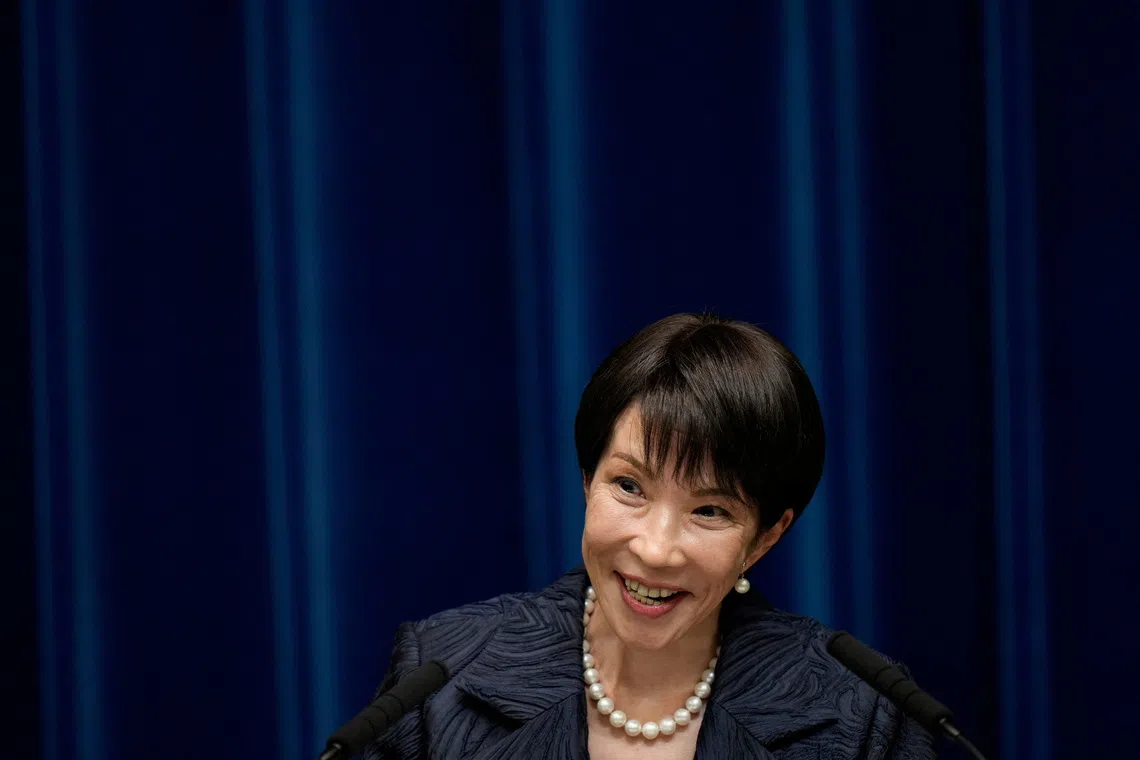Nuclear power at heart of new Japan prime minister’s energy policy
Sign up now: Get insights on Asia's fast-moving developments

Japan's new Prime Minister Sanae Takaichi speaks during a press conference at the prime minister's office on Oct 21.
PHOTO: REUTERS
Follow topic:
TOKYO - Japan’s new prime minister Sanae Takaichi is expected to push for the accelerated revival of nuclear power to tackle inflation, a source of public discontent, with reactor restarts key to reducing costly fuel imports.
Ms Takaichi has appointed Mr Ryosei Akazawa, who was Japan’s point person in its recent tariff deal with the US, as trade and industry minister, a portfolio that includes energy – signalling a willingness to engage with Washington, including on liquefied natural gas (LNG) purchases, analysts said.
Her government plans a package of purchases to present to US President Donald Trump during his visit to Tokyo next week, including LNG, although not for now from the Alaskan pipeline project championed by Mr Trump, Reuters reported on Wednesday.
However, Mr Akazawa said on Oct 22 that it was essential to maximise power sources that contribute to energy security and decarbonisation.
“We aim to proceed with nuclear restarts while taking concrete steps to gain the necessary understanding of local communities and stakeholders,” he said.
Japan spent 10.7 trillion yen (S$91.6 billion) in 2024 on imported LNG and coal, a tenth of its import costs. Imported fossil fuels cover 60 to 70 per cent of Japan’s electricity generation and are a source of inflation that has undermined support for the ruling Liberal Democratic Party.
Nuclear renewal
“PM Takaichi will almost certainly push for a more ambitious nuclear reactor relaunch. This is in part to support her push to bring down wholesale power prices while reducing fuel import reliance,” said Mr Henning Gloystein, managing director with Eurasia Group consultancy.
Before the 2011 Fukushima disaster, Japan operated 54 nuclear reactors. Of the 33 that remain operable, 14 have been restarted – a process that takes years. Securing stable new power supply is increasingly urgent as demand is poised to rise from data centre expansion.
Ms Takaichi, an advocate of nuclear power including next-generation fusion energy, has also voiced support for perovskite solar cells, technologies Japan can potentially export, and opposed massive solar projects given their reliance on panels imported from China and the environmental impact.
Costly large-scale renewables projects including offshore wind, already hit by Mitsubishi’s withdrawal, may get less political support, industry insiders say.
“Takaichi... in the long term, is unlikely to provide much support for the industry, as she favours nuclear restarts,” said an industry source involved in offshore wind policy discussions.
Energy diversification
Ahead of Mr Trump’s visit to Japan, US Treasury Secretary Scott Bessent has urged Tokyo to stop buying Russian energy, which mainly consists of LNG that accounts for 9 per cent of Japan’s imports of the fuel.
While playing down political pressure, Japan signed new US LNG purchase deals in 2025 but stopped short of hard commitments to the US$44 billion (S$57.1 billion) yet-to-be-built Alaska LNG project, under the wider bilateral trade agreement negotiated by Mr Akazawa.
“His ability to maintain dialogue with the US government, including on energy matters, is a positive factor,” said a high-ranked Japan utility company source.
Mr Akazawa, a 64-year-old English-speaker, understands the importance of affordable power, said Mr Tom O’Sullivan, director with Mathyos Global Advisory in Tokyo.
“There is also international pressure on Japan to cease purchasing Sakhalin-sourced LNG so that will also apply pressure to accelerate the restart of nuclear plants,” he said.
However, most Sakhalin-2 LNG contracts expire between 2028 and 2033, and earlier termination would result in fines for Japanese buyers, analysts have said. REUTERS

